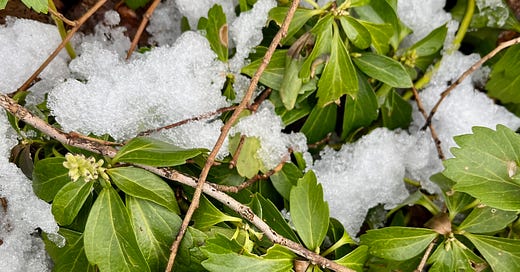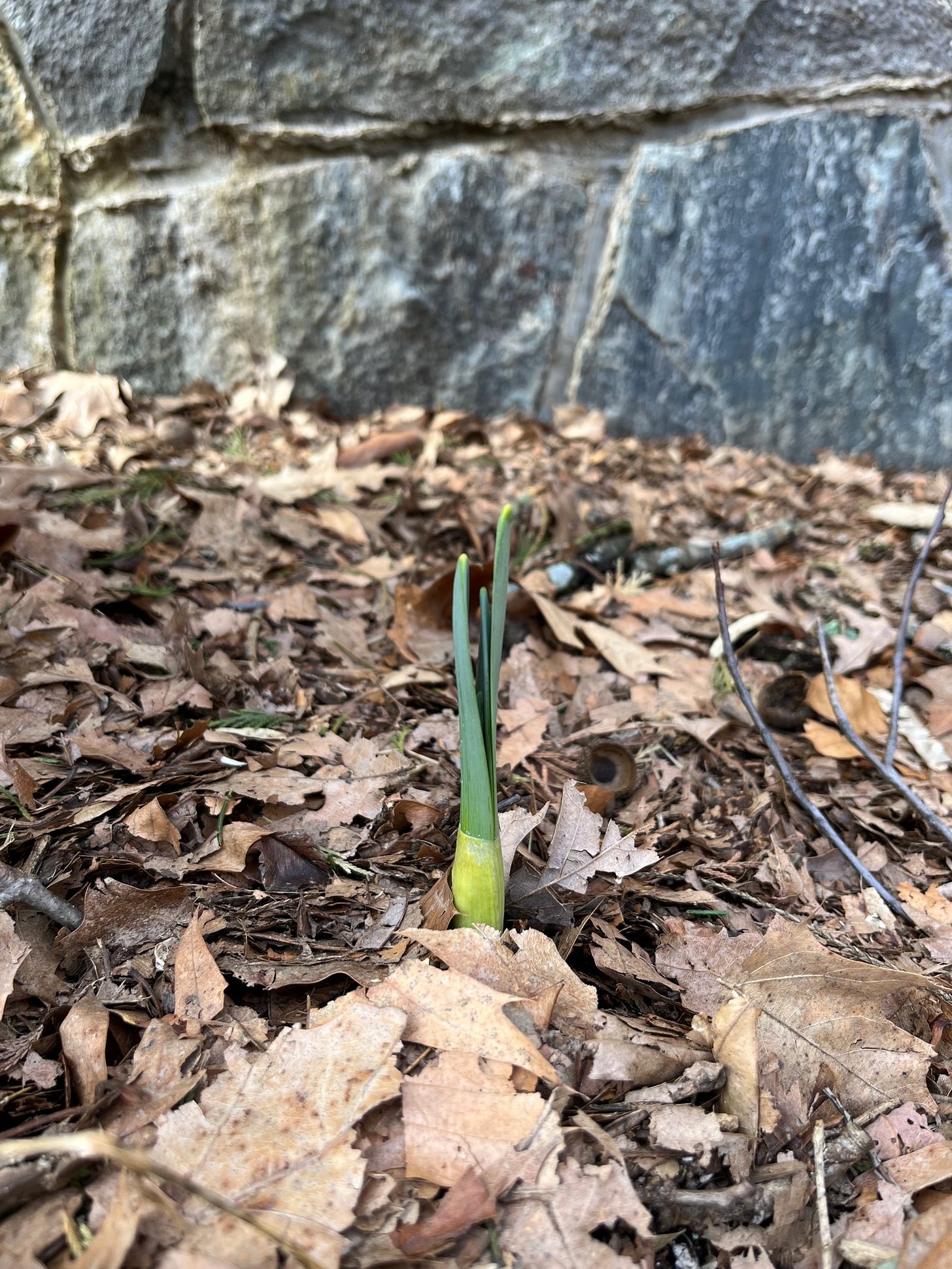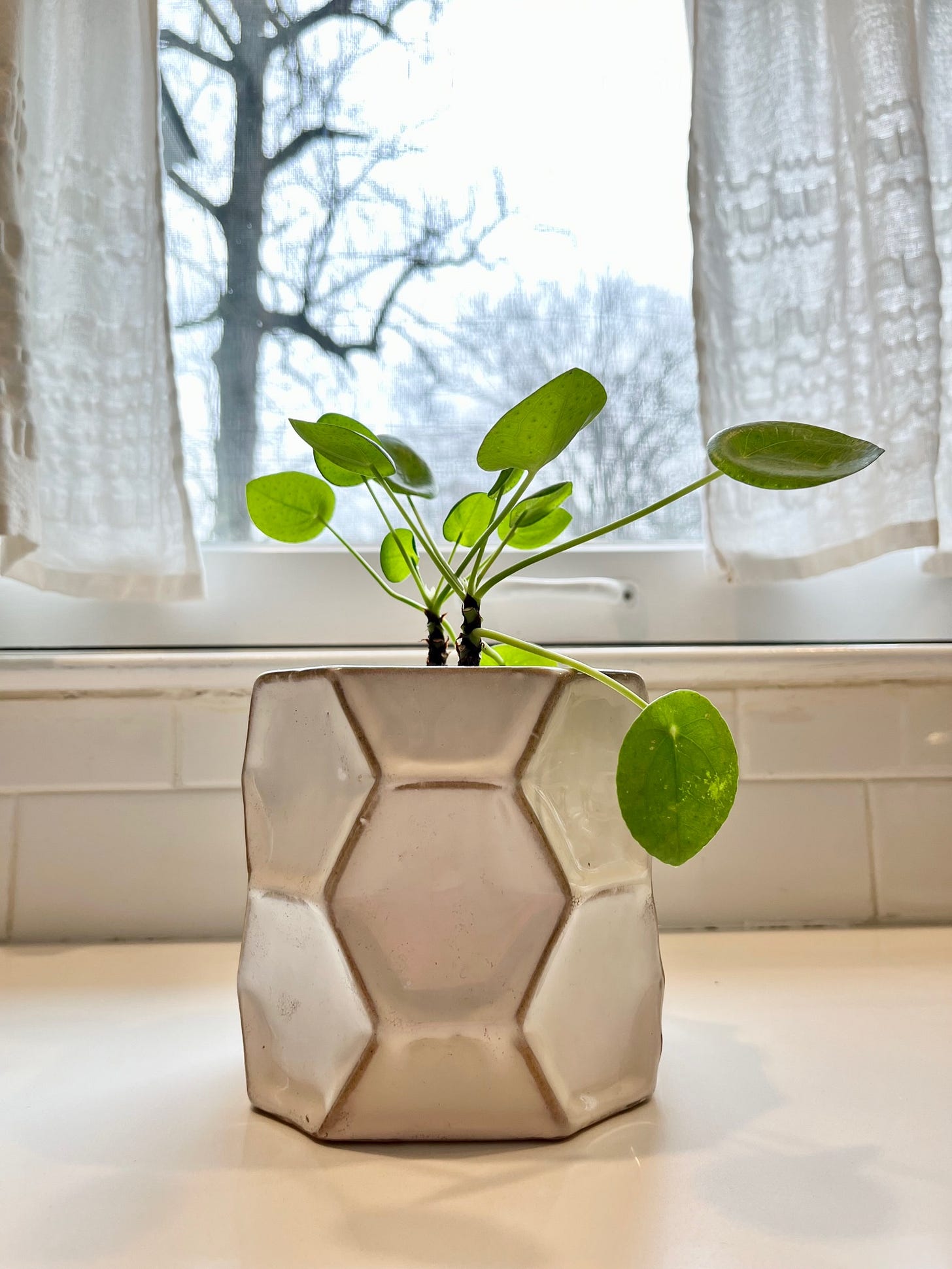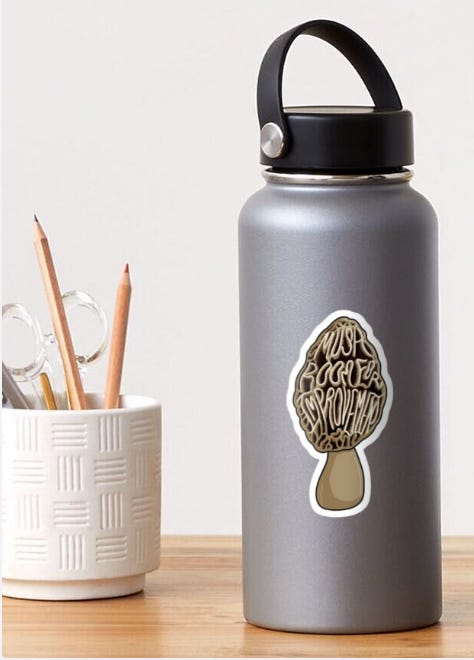We need our communities to support us in grief
In gardens and in grief, wintering is unavoidable...and sometimes necessary
The winter knocked me out
Frozen in an avalanche of doubt
It seemed like every road was buried under snow
So I thought
Better to forget the heat of the sunlight on my skin
I feel it coming but I'm scared to let it in
This change in the weather
Change in the weather
Maybe things'll get better
– The Beths, Change in the Weather
Every year, around this time, I notice that I’m both aching for spring to come, and also longing for a few more months to myself inside. Over time, as a gardener, I’ve come to notice that there’s a false dichotomy between the apparent barrenness of winter and the fertility of the spring. The stories of spring-blooming, snow-loving plants bear this out: we aren’t meant to have exclusively sunny days, nor are we forever stuck under the snow. Growth arises from the dance between these two polarities.
I wrote about this in the spring of 2023, when my hopelessness sprang from a a different source: my plans for family-building had been dashed, and I was writing retrospectively about the bereavement leave that brought me back to life.
May these older words below offer a new opportunity for us all to pause, breathe, and look deeply enough to receive this reassurance from the natural world around us: spring will come. It always does.
Winter is deeply purposeful for plants–amazingly so, given the fact that they cannot spend it arguing about who should win the Oscar for Best Picture, or watching the Super Bowl. (Dad joke from my husband, who edits these posts: “They do get to watch a lot of Superb Owls!”) They gather nutrients from their neighbors. They stop moving water through their membranes, so that their cells don’t freeze and die. They don’t just drop leaves, but re-metabolize them, using what no longer serves them in one year to nourish the growth of the next. (This is why many people where I live are pushing for leaf-blowers to become a thing of the past).
This happens while plants are in a state of supported rest. It’s the same kind we take in savasana after a yoga session, also known as “corpse pose,” as the teacher invariably urges us to “soak up all the benefits from our practice” (a real, science-backed thing). Or a quiet hospital room, where the staff leaves a meal for a slumbering patient. It’s not really solitude, nor dangerous isolation, but a calm and respectful cohabitating, a wordless being-with.
The growth that comes after a proper season of repose is unsurprisingly robust, a miracle of rebirth every time. Yet it does not rely on perfect conditions, but those polarities of sun and snow. The first shoots of spring flowers emerge into a brown, bare-branched world, it’s true, but the filtered sunlight allows them to soak up maximum sunshine without burning their still-tender shoots. Meanwhile, the cold temperatures and snow, as well as the leaf mulch from surrounding trees, serve to wrap the infant flowers in a soft blanket, a second skin, protecting them from freezing and certain tiny beasties that will stalk them later in the soil. Without these seasonal rhythms, they’re more susceptible to disease.
It is the natural world’s ability to embrace both/and, to hold the paradox of cold and heat, that allows us to finally awaken again in a blooming world.
Humans in grief also need time for our inner and outer worlds to come back into balance, to grow back as strong or stronger than we were before.
There are many high expectations for teachers at this time of year, ranging from the grueling to the silly, that feel out of step with this season of rest, which is a topic for another time for me (but was brilliantly covered in Culture Study this week). As I wrote in a prior post, my workplace had the infinite grace to excuse me from those expectations for a time after we lost our daughter-to-be in late pregnancy last year. Their compassion kicked off an initiation for me, into a slower, more seasonal experience of grief than I had ever experienced before.
Thanks to my bereavement leave, I slipped into the quieter rhythms of my garden and woods, cohabitating with my husband and son like a tree suddenly shorn of limb or leaf. We survived on the kindness of friends and sitters and neighbors, who sent food and fuzzy socks through our mycelial networks. One friend even sent us a little green plant, its leaves shaped like a fistful of balloons, beacons from a green future that we couldn’t yet see.
At first, I wasn’t sure how to spend my time. Like many Millennials, I had never really been taught how to rest. I did spend some time in savasana. But my real salvation was taking slow walks outside. I walked into fields of snowdrops coming up from the softening ground, and I watched them covered up again with fresh snowfall. I walked through days of mist, a mist that is recognized as an entire micro-season in Japan. The kind of mist that rises up in conditions where cold and wet dance with sudden heat and light, obscuring and then revealing the path ahead.
My urge to walk felt instinctive, blind, urgent, even angry – like a spiky tulip tip that only knows that it has to push and push hard, through darkness towards warmth. Yet science suggests there was real merit in this movement. Walking in forests or parks, and/or “forest bathing,” according to Kaiser Permanente, has “been found to lower blood pressure, heart rate, and levels of harmful hormones — like cortisol, which your body produces when it’s stressed.” Walking outside in green spaces for at least 120 minutes per week, according to Scientific Reports, has been shown to be negatively correlated with use of medical services and with mortality, and higher subjective experiences of wellbeing.
Taking the forest cure didn’t make my grief disappear, but it did help to metabolize it, as though the dropped leaves of my now-impossible future had begun to return their energy to my aching postpartum bones.
Because I had wintered, I found I really was ready to emerge aboveground, to start growing real leaves again like the oaks and maples around me. Ready to come back into reciprocity with the beings around me. This meant going back to all of those un-restful expectations that go on inside schools, but it also meant seeing my beloved coworkers again, checking on my students, becoming whole again in community and not in isolation.
With modern grief, particularly grief in America, there is a sense that any state of supported rest like this should be as short as possible. Our culture demands that the injured or the postpartum or the grieving quickly get back to being happy, which makes other people around them happy. More pointedly, economic conditions often demand that they get back to being productive, which makes other people around them wealthy (though rarely does that include us teachers).
There seems to be a mass delusion that, with sufficient grit, we can shift our inner climates to mirror that of Southern California, 70 and sunny all the time, with no winters anywhere to stop the flow of consumables traveling from coast to coast. Too many people are willing (or forced) to follow these directives — sneaking out of yoga before savasana to make their next meeting, ejecting the patient from the hospital before they are fully recovered.
It’s easy, in loss, to follow this cultural conditioning instead of your own instinct – to look to action and planning as the solution for sadness instead of to slowness. I have struggled mightily with this. But expecting the same returns from a being or system suddenly under new strain is just not sustainable, for me or for anyone. There’s no real way for the grieving to skip the winter that befalls us, wherever and whenever our loss occurs, or to make it go away before its time. Whether on the inside or the outside, winter is here to serve a purpose: to wrap us in a second skin, so that we can heal and rest and re-grow safely, then return to a state of reciprocity with our communities.
I’m glad my workplace respected this about me. I’m encouraged by the many cities and companies that are mandating more leave for all bereaved parents. America, once a tapestry of tribes that lived in balance with each other and the land, has razed its old-growth forests and replaced them with a culture of short-cuts and clear-cuts. But there is still time to shift our ways back to ones that center real resilience, relationship and rest. February’s transition into March reminds us that wintertime isn’t over, if we still want it.
Further Reading:
The Beths, quoted above, got me through the entirety of 2023. You can find the song above on my Let The Leaves Lie playlist, which has soundtracked many of my cold-weather woods walks.
If you would like to see better policy in place for bereaved people, check out this piece. It shows that D.C., Pittsburgh and Portland are already developing stronger public guidance for businesses along these lines, while companies like Pinterest and Goldman Sachs are leading the way in the private sector–making it easier to point out to your local representative or boss that they, too, should be ahead of the curve.
If you are a teacher or parent who is finding it overwhelming to keep up with the bag-stuffing, door-decorating parent or teacher next door during this season of rest, this piece by
may help you feel less alone (and give you a laugh).The ancient Japanese calendar actually has 72 distinct seasons, with beautifully lyrical names. This article lists them all, and this beautifully-designed app will tell you which mini-season you’re in at any given time. The latter also includes haikus, art, and recipes. It is one of the things that is bringing me delight right now.
Finally: A friend of mine (who has asked to remain anonymous) recently gave me something even better than a Substack comment: she was so inspired by my musings about the magic of fungi, she said, that she made this incredible “Mushroom for Improvement” decal, and I love it so much. Currently on sale for two bucks, which is less than an actual mushroom but far more appealing to carry around. Check her out if you are so inclined!









Exactly this, my entire first year of divorce: “My urge to walk felt instinctive, blind, urgent, even angry – like a spiky tulip tip that only knows that it has to push and push hard, through darkness towards warmth.”
I love the concept of forest bathing! Also Superb Owls... I legit laughed out loud at this on the train. Please pass my punpreciation to your husband. 😂
Thank you for writing this beautiful reflection. I love the resources you've included here. You've cultivated the courage to create something meaningful to share out of your pain, for which I'm grateful. 💗